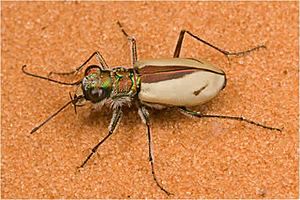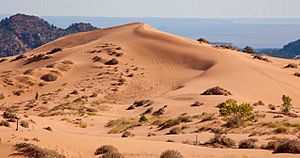Coral Pink Sand Dunes tiger beetle facts for kids
Quick facts for kids Cicindela albissima |
|
|---|---|
 |
|
| Conservation status | |
| Scientific classification | |
| Kingdom: | |
| Phylum: | |
| Class: | |
| Order: | |
| Family: | |
| Subfamily: | |
| Genus: |
Cicindela
|
| Species: |
C. albissima
|
| Binomial name | |
| Cicindela albissima Rumpp, 1962
|
|
The Cicindela albissima, also known as the Coral Pink Sand Dunes tiger beetle, is a special kind of tiger beetle. It lives only in one place: Coral Pink Sand Dunes State Park in southern Utah, United States. This makes it an endemic species, meaning it's found nowhere else on Earth!
Scientists first described this beetle in 1962. At first, they thought it was just a type of another beetle. But later, by studying its DNA and unique features, they realized it was a completely separate species. You can tell this beetle apart from others by its limited home range and its white wing covers, called elytra, which have very little color.
Contents
Meet the Adult Tiger Beetles
Adult Coral Pink Sand Dunes tiger beetles are about 10.5 to 12 millimeters (around half an inch) long. Females are usually a bit bigger than males. Their body, called the thorax, is brown or bronze. But their wing covers (elytra) are mostly white.
These beetles are predators! They mostly eat flies and other small bugs they find on the sand dunes. They also act like nature's clean-up crew, scavenging on dead bugs that get blown onto the dunes.
When Do Adult Beetles Appear?
Adult beetles start coming out of their young stage in March. They are most common in mid-April to early May. Their numbers slowly drop through June and they are mostly gone by July. Mating and egg-laying happen from March until the adults die off. Sometimes, a few adults can still be seen from late August to early October.
How Do Adult Beetles Live?
Adult beetles are usually active on warm, sunny days. When it gets dark or the weather is bad, they dig small burrows to hide in. Scientists haven't seen many parasites bothering these beetles. Most adult beetles don't travel very far, usually less than 300 meters (about 1000 feet). However, some have been seen moving up to 1000 meters (about 3300 feet).
Life as a Larva: Young Beetles
After the adult beetles mate in early spring, the first young beetles, called larvae, start to appear in late spring. They usually finish their first growth stage by late May or June. Most of them reach their second growth stage by mid-summer. By fall, they are in their third growth stage.
These larvae spend the winter sleeping (hibernating) before they turn into adults the next spring. Larvae don't move around much. They live in permanent burrows and wait for food. When other small bugs pass by the opening of their burrow, the larvae use their strong jaws, called mandibles, to catch them.
Where Do These Beetles Live?
The Coral Pink Sand Dunes tiger beetle lives only in the Coral Pink Sand Dunes. This area is part of Coral Pink Sand Dunes State Park in Kane County, Utah. They live on about 20% of the park's 3,500 acres of dunes. Their home is about 1.8 kilometers (5,900 feet) long and 300 meters (1,000 feet) wide. The dunes are about 11 kilometers (7 miles) west of Kanab. The southern part of their habitat is less than 1.6 kilometers (1 mile) north of the Arizona border.
Protecting the Coral Pink Sand Dunes Tiger Beetle
The Coral Pink Sand Dunes tiger beetle has been suggested for protection under the Endangered Species Act. It was once thought to be a subspecies of another beetle, but it lives over 595 kilometers (370 miles) away from any other populations of that beetle. Its unique location, DNA, and physical differences (like its white wing covers and body size) show it is a distinct species.
Population and Threats
In 2012, scientists estimated there were about 1,786 of these beetles. This was an increase from 1,116 in 2011. Since surveys began in 1998, the population reached its highest point of 2,944 beetles in 2002. The lowest number was 558 in 2005.
The amount of rainfall is the main thing that affects how many beetles there are. Drought (not enough rain) is the biggest danger to this species. Off-road vehicle (ORV) activity has also damaged the beetle's home. This is especially true in the low areas between the dunes, where most of the young beetles (larvae) live. When ORVs damage plants, it can harm the larval habitat and reduce the number of bugs the beetles can eat.
Conservation Efforts
To help protect the beetles, a special conservation area of about 150 hectares (370 acres) has been set up. In this area, off-road vehicles are not allowed. This protected zone covers about 80% of the beetle's suitable habitat. In 2012, 87% of the beetle population was found within this conservation area. This was a big improvement from previous years, likely because of the new protected area and stronger rules within it.



